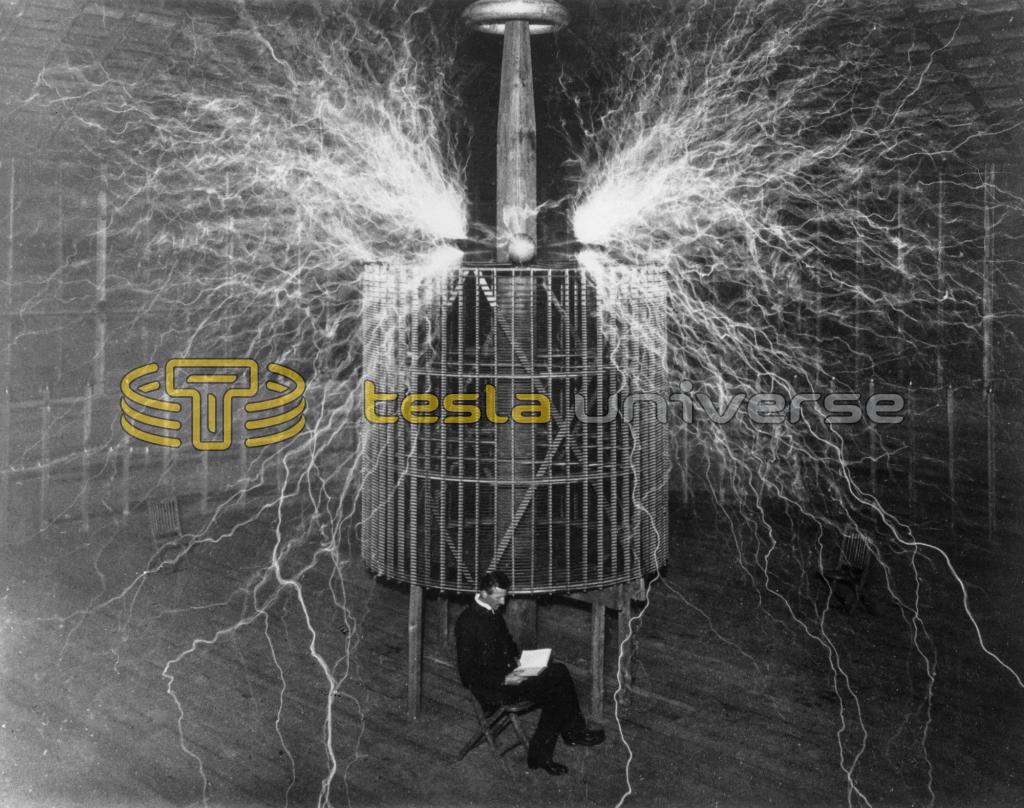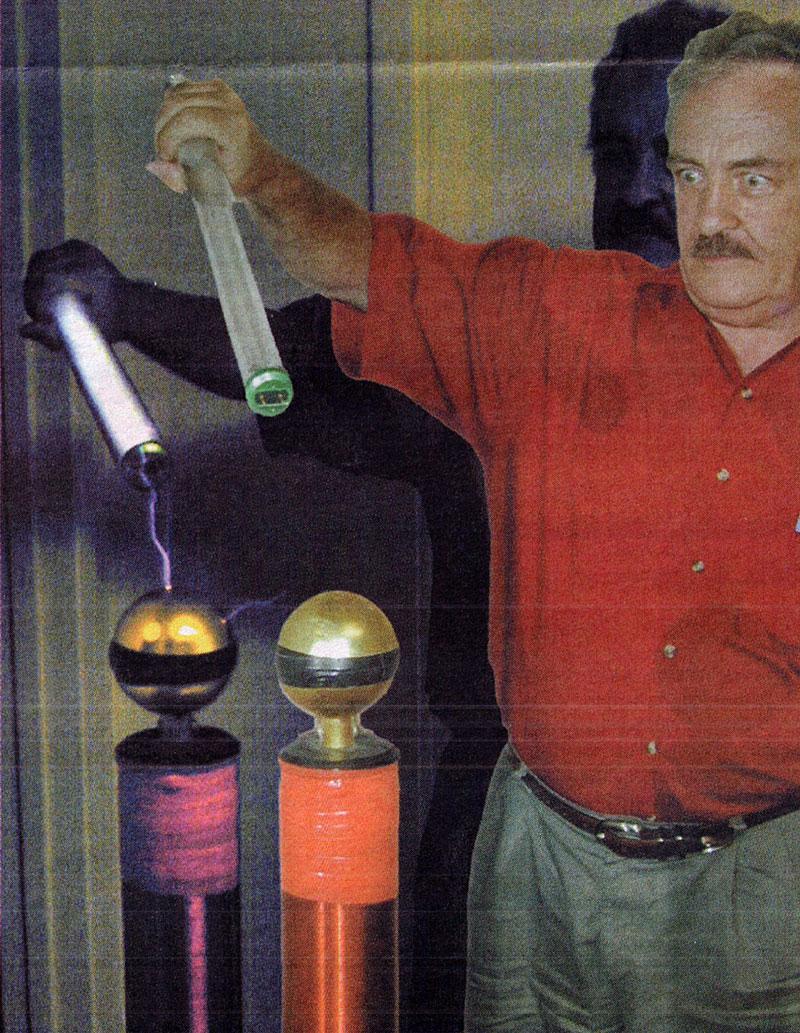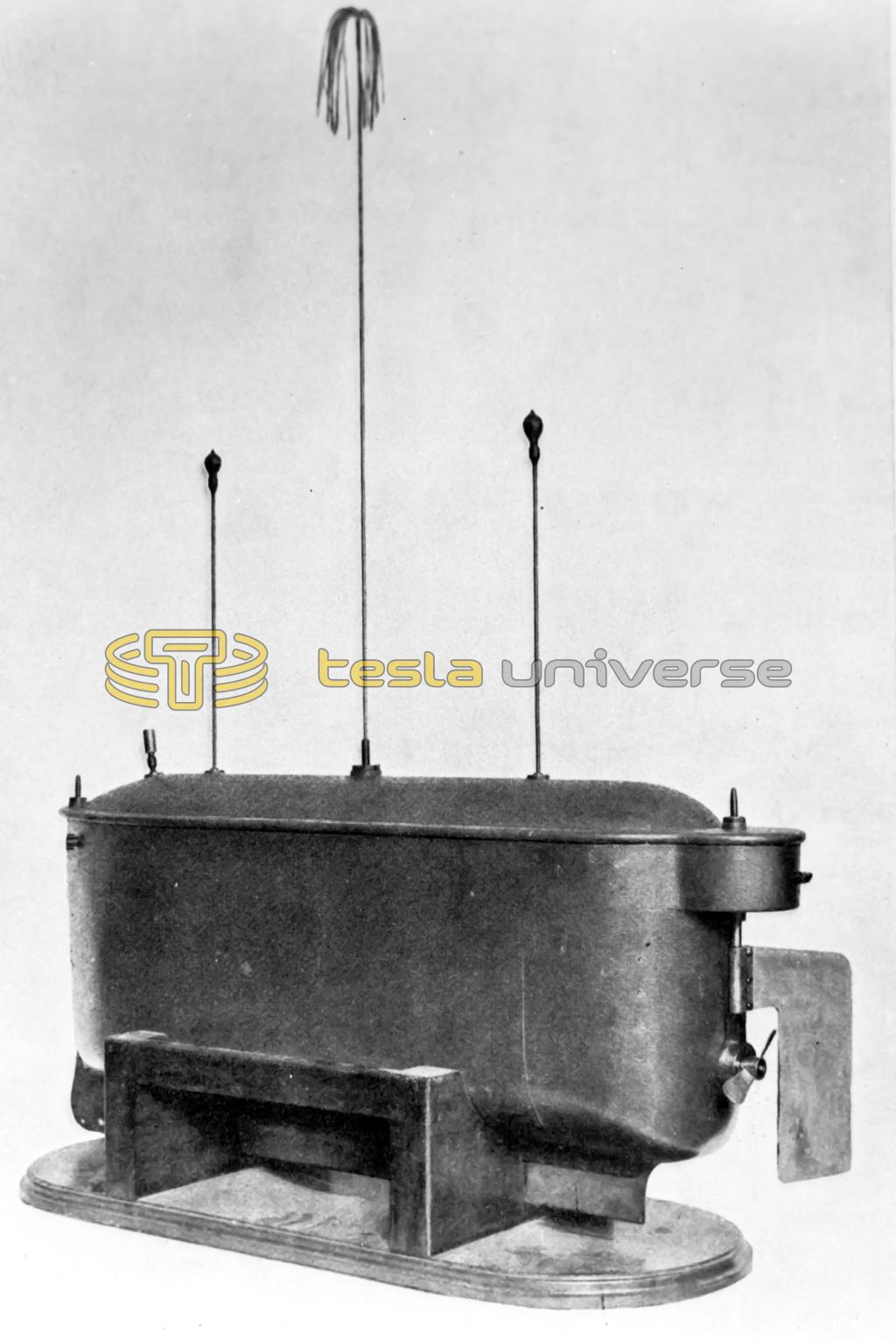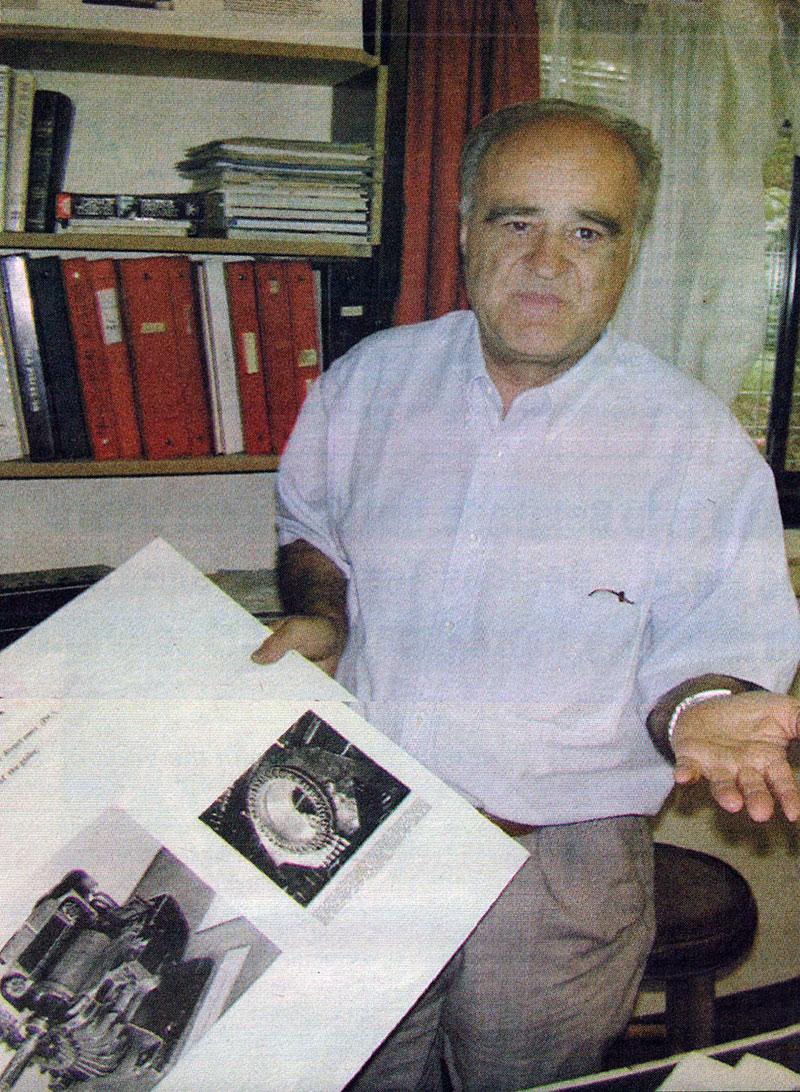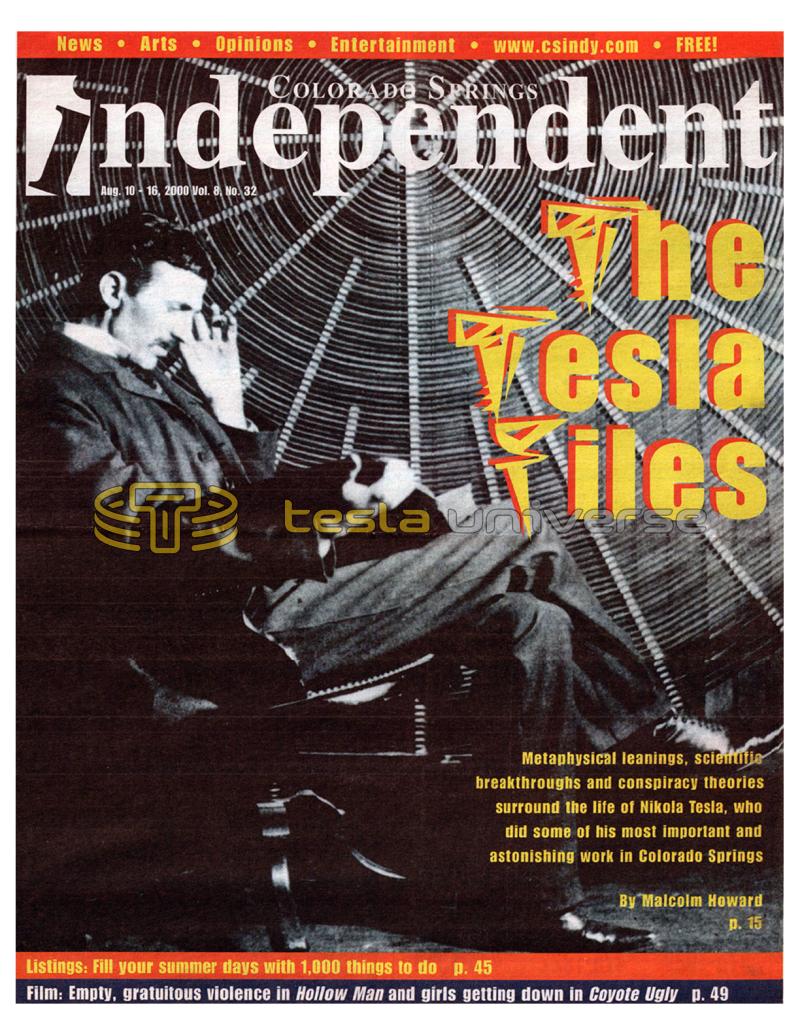
Nikola Tesla Articles
The Tesla Files
Metaphysical leanings, scientific breakthroughs and conspiracy theories surround the life of Nikola Tesla, who did some of his most important and astonishing work in Colorado Springs.
Somewhere on North Foote Avenue, just up the hill from its intersection with Pikes Peak Avenue, a small house stands where 101 years ago, Serbian-American inventor Nikola Tesla built his famed, and now long-gone, Colorado Springs laboratory.
It was a small, barn-like structure built on a once-grassy knoll, which then served as pasture land. From the center of the structure, an 80-foot tower loomed over the flat grasslands. Signs on the door reportedly read: “Keep Out, Great Danger” and “Abandon hope, all ye who enter here,” according to biographies of the man.
Where “here” is isn't exactly clear, and I'll avoid naming the address that is believed to be the location to spare the present-day homeowners a repeat of what happened the last time word leaked about the locus of the former lab:
Strangely clad visitors meditated on the sidewalk.
“It was on the 3rd of July — the date I shall never forget — when I obtained the first decisive experimental evidence of a truth of overwhelming importance for the advancement of humanity,”
— Inventor Nikola Tesla on experiments and observations he made in Colorado Springs
A man in a VW bus parked at the site for several days and tried to invoke Tesla's spirit.
Pilgrims of physics — and metaphysics — had come to pay homage to the man who said he made his most important discoveries on the small rolling hill just adjacent to the Colorado Springs Deaf and Blind School.
While it would be easy to poke fun at those who migrated to North Foote hoping to absorb any lingering vibes or energy left by Tesla's experiments, it's undeniable that something unique and powerful happened at the site.
Tesla himself felt that his work in Colorado Springs would change the planet. “It was on the 3rd of July — the date I shall never forget — when I obtained the first decisive experimental evidence of a truth of overwhelming importance for the advancement of humanity,” Tesla wrote in his journal.
In short, as lightning got farther away, the pulses being picked up by Tesla's equipment didn't fade. Tesla felt he had discovered evidence that the Earth itself contained “stationary waves” that could serve as a good conduit for electromagnetic energy, opening the possibility of worldwide, instantaneous communication and global transmission of power through the Earth's crust.
Many modern physicists don't buy this notion, but perhaps the man in the VW bus was contemplating the implications of that: free power for the masses, anywhere on the planet, without messy power lines cluttering up the streetscape.
Or perhaps he was simply trying to imagine what the hill looked like 101 years ago this summer, when on a crisp summer night, Tesla and his assistant Kolman Czito, sent 12 million volts flying through their 80-foot mast, shooting bolts of lightning 145 feet in all directions.
The dazzling light display that night ultimately sent Colorado Springs into darkness after a generator operated by the city power company melted down. It took weeks of pleading from Tesla, along with the promise to fix the generator free of charge, before the power company reconnected the juice to Tesla's lab.
Or perhaps the man in the van was lamenting, as Tesla enthusiasts often do, that the eccentric inventor who called the Springs his home for a year at the turn of the 20th century is still not afforded the recognition he deserves.
After all, Tesla either invented or theorized technology that is now ubiquitous: alternating-current electric motors, radar and radio among other things.
While hardly missing from the history and science texts, Tesla's name is far less celebrated than contemporaries such as Guglielmo Marconi, who got credit for inventing wireless transmission even though Tesla had demonstrated such a system two years earlier.
Some, like J.W. McGinnis, one of the area's most enthusiastic Tesla buffs, feel Tesla is shunned largely because his ideas are too radical for the larger scientific community and the industry that supports them.
“They can't acknowledge Tesla technology because it basically puts them out of business,” says McGinnis, the former director of the now defunct Nikola Tesla Society and founder of the newly created International Tesla Institute (see www.tesla.org).
Whatever the reason, there's no doubt that Tesla's legacy is not widely bandied about in Colorado Springs, where the inventor settled largely because the high and dry climate afforded a uniquely charged atmosphere for his experiments. In one three-hour period, Tesla says he counted upwards of 12,000 lightning strikes in the area detectable by his equipment.
Today, Tesla is more underground than ever. Last year the 16-year-old Tesla Society went bankrupt, and most of the artifacts it displayed in its small museum on East Bijou Street, replicas of Tesla inventions and models of his lab, were put up for auction.
Most of the museum's assets, scale models of Tesla's lab and replicas of various inventions are now owned by a man in New Jersey who placed the highest bid.
It's a sad turn of events since the society's quirky, hard-to-find museum on East Bijou Street was the only place that tourists and locals could get a hint at what Tesla's lightning machines can do.
Everyday, volunteers gave tours to small groups of amazed onlookers who watched as lightning bolts filled a small room with crackling tendrils of electricity.
Now, the only public remembrance of Tesla's legacy in Colorado Springs is a small, laminated plaque adorning a historic marker that's tucked into a clump of trees on Memorial Park's northern border along Pikes Peak Avenue.
“It was at this facility on North Foote Avenue that Tesla felt he made his most important discoveries,” states the plaque, which age has made hard read through cracks, stains and decay.
Look folks, no wires
Click the remote at your TV screen and you've used at least a few of the technologies pioneered by Nikola Tesla more than 100 years ago.
First, there's the AC power flowing into your boob tube. Tesla pioneered alternating current, or AC, over the objections of his rival Thomas Edison, who thought DC, or direct current, should be the standard.
While the technology used in the modern-day channel clicker has evolved considerably from Tesla's day, it was Tesla who first developed and promoted remote control technology.
Then there's the TV tube itself, which borrows significantly from the Tesla coil, a high-voltage oscillator that shoots energy at the gasses contained in the television's picture tube.
If you're watching reruns of Desert Storm, you could give some credit to Tesla for pioneering the smart bomb. One of Tesla's pet projects was a torpedo that could be steered to its target using a twofold circuit system that prevented enemies from commandeering the missile and turning it back at its sender.
And let's not forget radar. It was in Colorado Springs that Tesla honed his hypothesis that remote objects could be detected using electromagnetic waves. Though Tesla never built a radar, he foresaw its development more than 50 years before it came into being.
“The only real Tesla Museum is in Belgrade, but that's not where he did any of his scientific work. ... Besides, Tesla cherished his U.S. citizenship more than anything, more than even his scientific accomplishments.”
— Tesla enthusiast J.W. McGinnis on why Tesla deserves a museum in the good ol' USA
As with any scientist around the turn of the 20th century, Tesla did not work in a vacuum. His work built on discoveries already made by Faraday, Edison and Hertz, among others.
While some scientists of his day discredited him as adding little to the knowledge gained by his predecessors, the statements of others indicate otherwise. E.H. Armstrong, the inventor of FM who worked with the Allies in creating radio-controlled weapons during World War II, credited Tesla more than any other for laying the foundation for his work.
But that's only part of Tesla's legacy.
His most ubiquitous invention is around us all the time: the AC induction motor. Today, this little gizmo is everywhere, from factories to your electric lawnmower; but at that time, electric motors were basically running on DC power, which was the preferred means of lightning up cities and towns in those days.
Cleverly, Tesla figured out how to use AC's push-me-pull-you nature to spin a rotor inside a ring of magnets, making an engine that could run on the easier-to-transmit alternating current.
Tesla's biggest coup came in 1893, when he and his benefactor George Westinghouse won the bid to supply AC power to the World's Fair in Chicago over the bid of Edison's DC. That set the stage for the use of AC as the national and international standard.
Over his lifetime, Tesla would accumulate over 700 patents and make discoveries that would prompt preeminent physicists to make statements like this one, from famed British inventor, Lord Kelvin in 1886: “Tesla has contributed more to electrical science than any man up to his time.”
In 1960, 17 years after Tesla's death, the International Commission of Electrical Engineers gave a high honor to the deceased inventor, naming a unit of measurement for the strength of a magnetic field, the “tesla,” abbreviated as a “t.”
According to Tesla historian James Corum, the inventor's mark was even felt in the modern information age. “Most computer scientists are aware that, when certain hardware manufacturers attempted to patent digital logic gates after World War II, the U.S. Patent Office asserted Tesla's turn-of-the-century priority in the electrical implementation of logic gates for secure communications, control systems, and robotics.”
Interestingly, Tesla still fails to receive due credit for one of his most profound discoveries — the first transmission of electromagnetic energy without wires.
“Most electrical engineers are unaware that, as late as 1943, Nikola Tesla — not Marconi — was recognized by the U.S. Supreme Court as having priority in the invention of ‘radio,’” Corum continues.
Tesla vs Marconi
Pick up any science textbook, however, and Tesla gets short shrift next to his Italian-born rival Guglielmo Marconi.
Here are just a few examples:
A science Web page hosted by the Public Broadcasting System gives a lengthy discourse about Marconi having made the first wireless transmission — a questionable statement in light of Tesla's work — while a search for the name Tesla on this site comes up with no findings.
The third edition of Webster's New World College Dictionary identifies Tesla simply as a U.S. inventor born in Croatia, while it lists Marconi as an Italian inventor who “developed wireless telegraphy.”
The Marconi Corporation, which still exists in England, where Marconi launched his radio empire, refers to its namesake in company Web pages as the person who sent the first wireless transmission.
Textbooks for teachers at D-11, meanwhile, often mention Tesla and Marconi in fairly equal terms, but a majority make the questionable claim that Marconi invented wireless transmission while omitting discussion of Tesla's work in the area.
Why has Tesla taken such a backseat? Part of the reason is that his contemporaries produced many more practical applications for the technologies they were inventing.
There's no doubt that Marconi worked harder on the practical military and commercial applications of radio as we know it today. Still, it's not correct to say, as many texts do, that he was the first to send a wireless transmission.
In 1895, Marconi sent his first transmissions to his family's villa in Italy. Tesla, however, publicly demonstrated wireless transmission two years earlier, in 1893, and his first radio-related patent was granted in 1898, two years before Marconi's. In short, Tesla showed how four circuits tuned to pick up specific frequencies could be used to broadcast and receive electromagnetic waves. It was a simple device. A transmitter sent a wave to a receiver, which then illuminated a small bulb.
But because Marconi figured out, step-by-step, how to send radio message farther and farther — capping it off with the first message across the Atlantic — Marconi has since been hailed as the inventor of modern radio.
Tesla.com
A physicist who used to work at Argon National Laboratory in Chicago, and for a variety of high-tech firms, Maglic is also from Serbia, a country where Tesla is revered almost like a saint.
“There's a Serbian saying, ‘It's hard to come from a small nation and be a big lion,’” Maglic says. “He came from a small country. He was also an idealist. He was the son of a long row of priests — his father wanted him to be a priest — and he came to a country that was based on profit.”
Indeed, throughout his career, Tesla seemed more interested in developing and demonstrating innovating technologies than making the best widget — or radio, for that matter.
Not that Tesla didn't want to be milionaire; he did, and he was intuitively aware of how his inventions could revolutionize industry and society.
But while Marconi was staging high-profile publicity stunts to single-mindedly advance the practical application of radio, which Marconi worked feverishly to improve and make useful for military, civilian and commercial applications, Tesla produced no off-the-shelf products from his work in Colorado Springs.
His local legacy is also diminished, Tesla researchers say, by the fact that Tesla was here for less than a year before he packed up, went back east and built Wardenclyffe, the ill-fated lab in Shoreham, Long Island.
While his experiments here gave Tesla the confidence to go back to New York and convince Morgan to lend him more capital for Wardenclyffe, the fact is that many of the ideas generated in Colorado Springs never came to fruition because Morgan withdrew financial support.
Meanwhile, the city's premier history venue, the Pioneer Museum, has little on Tesla, largely because there are no true artifacts available locally for display.
Still, Maglic seems truly saddened by the fact that, last year, the city of Colorado Springs barely marked the 100 year anniversary of Tesla's famous experiments. “There was very little,” Maglic says, pointing to some 100th anniversary posters that he and others developed for a demonstration at a local school.
“I'm not aware of any real events commemorating his work here.”
And now, without the Tesla Museum, the city of Colorado Springs has no significant remembrance of a man who used the city's unique features — elevation, climate and high level of static — as a springboard for some of the last century's most bodacious scientific research.
Why, in this haven of roadside tourist attractions, isn't there a place where a passing tourist can stop, pay $5 and get a quick trip into the light fantastic? Why is there no replica of Tesla's famous lab?
In a way, it would be fitting for Colorado Springs to be more of a demonstration site for Tesla's flashier technology given that most of his work here was fairly theoretical and even a bit theatrical. Imagine a Fourth of July fireworks show that included the local symphony orchestra playing the snapping of a gigantic Tesla coil.
For his part, Maglic thinks the next step is to buy a house where Tesla technology can be displayed without the burden of extremely high rents, which he said really crimped the Tesla Society in the past. “We were paying something like $2,500 a month; it's hard to raise that kind of revenue with a small museum,” Maglic said.
For his part, McGinnis, who served as the society's former director, is working on a book about the inventor, among other projects. While he's recently founded the International Tesla Institute, he's not sure he wants to take on a museum project without some financial backing.
It's a tough challenge, given that, even in New York, where Tesla did the bulk of his most important work, there's no real Tesla museum commemorating the work he did there. “The only real Tesla museum is in Belgrade, but that's not where he did any of his scientific work,” said McGinnis. “Besides, Tesla cherished his U.S. citizenship more than anything, more than even his scientific accomplishments.”
“Most electrical engineers are unaware that, as late as 1943, Nikola Tesla — not Marconi — was recognized by the U.S. Supreme Court as having priority in the invention of ‘radio.’”
— Tesla historian James Corum
Weird science
My first encounter with the spirit of Nikola Tesla came a few years back when I was asked to write a story about some of the more interesting museums that grace the local area.
The Tesla Museum was at the top of my to-do list.
The first challenge was finding the place. The address was listed as 2220 East Bijou, but driving back and forth across from the old Montgomery Ward's outlet, I saw the numbers go from 2210 to 2230 with no sign in between of a museum.
Only after I drove around back did I find a nondescript door of an office building leading into the Tesla Museum.
The search paid off. The first room was full of books about Tesla and the strange technologies he can be linked to: an Air Force plan to shoot electromagnetic rays into the ionosphere, evidence of secret experiments and aliens at Area 51, pamphlets that describe how to build your own lightning machines.
In the next room, there was a wooden model of Tesla's famous Colorado Springs laboratory, adorned with a wooden tower from which the inventor broadcast his electrons.
There were reproductions of Tesla's AC motors, his turbo pump and lots of pictures of spark-throwing devices. Best of all, though, was the video and the tour, which ended with a demo of the Tesla coil, the famous Frankenstein-like contraption that shot lightning bolts across the room.
As luck would have it, it turned out my guide for the day was none other than Mike McKee, a local ultraconservative Christian activist who launched a campaign against businesses that advertise in the Independent.
At the time, I had no idea who McKee was: that he had a radio show and Website that railed against media establishments like mine and predicted that the armies of Satan would try to take over the world after Armageddon.
I only knew that he put on a good show.
To demonstrate the power of static electricity and the power of electricity to move through the air, McKee used florescent lightbulbs that showed how inanimate objects can store up and conduct electricity.
When McKee touched the nodes of the bulb to the ceiling, or to the hand of someone who had just touched a Tesla coil, the bulb would light up, not brightly, but enough to make his point — that we don't need a network of copper wire, controlled by the utility elites, to distribute electrons to people who might find them handy.
Because this technology would mean the end of power monopolies, the technology has been hidden from the people, McKee suggested, punctuating his talk with constant asides that this is information “they don't want you to know.”
Though he never defined who “they” were, he suggested that this information is being kept from you because having such information would allow you to unhook yourself from the clutches of bloodsucking energy monopolies.
The most impressive trick was saved for last. McKee turned out the lights then threw a switch on a large Tesla coil that threw sparks across the room and left the unmistakable smell of burnt ozone.
As someone who's always fancied the vision of living off the grid and being self-sufficient, I was sympathetic to McKee's case. But after his talk, when I asked him if he could show me how I could work on using static electricity to light a hallway or study, he suddenly became circumspect. He said it was something he uses for his demonstration and doesn't want to reveal how it's actually done. So much for them not wanting me to know about this stuff.
The real diatribe came after McKee learned I was writing a story for the Independent. (I had probably asked to interview him or get a spelling of his name.) He railed on me for at least a half-hour about how the Indy is unfair to Ed Bircham, the local office products merchant who rants against the evils of homosexuality and who has stated publicly that he doesn't like black people.
To be fair to the Tesla Society, McKee was one of several volunteers who conducted tours at the museum and each one had a different take on Tesla's legacy and its implications for modern society. My only real gripe with McKee's lecture was that he failed to mention the potential downsides of broadcasting huge amounts of electricity into the Earth's crust, or into the sky. Electromagnetic energy has been linked to cancer and who knows what an amplification of Tesla's ideas would do to migrating birds, butterflies and whales.
McKee's spiel is worth mentioning because it demonstrates the variety of ideologies, many of them on the fringes of political discourse, that run through the Tesla crowd.
People from far left to far right can admire Tesla's visionary notion of electrical self-sufficiency, whether or not Tesla's specific technology is indeed practical or environmentally sound given today's understanding of biology and physics.
Tesla's technological advances also draw a following from practitioners of New Age medicine, who are intrigued with Tesla's comments on the positive health effects of electromagnetic energy on the body and his writings on energy and the human body, mind and spirit.
The Web site for the International Tesla Institute, a new membership group set up by McGinnis, devotes as much time to the famed inventor as it does to marketing products derived from Tesla innovations.
Consider if you will the “Mosquito Terminal,” a device that uses electromagnetism to snare bugs; “Space Oil,” a solve-all lubricant made from seeds, and “bio magnetics,” the use of magnets as therapy for a variety of ailments.
There's also a sci-fi following.
Using sensitive equipment that he developed for his lab on Foote Avenue, Tesla picked up electromagnetic pulses that may well have come from space. The pulses were probably waves sent from distant stars, which astronomers today rely on for a variety of data. Tesla, however, speculated publicly that the electromagnetic waves were coming from inhabitants of Mars, a claim that brought ridicule from the scientific establishment of the day.
Perhaps it's Tesla's legacy as an eccentric underdog, someone who didn't quite fit in with the profit-driven mentality of the Morgans, Westinghouses and Edisons, that cements his reputation.
But it's also possible that because Tesla fans function at the fringes of scientific debate, embracing a variety of anticorporate, antigovernment conspiracy theories, it's easier for establishment science to ignore the Tesla cause through a sort of dismissal-by-association.
It's also the case that during his career, but particularly later in life, Tesla got in the habit of making fairly wild claims, speculating publicly on theories that he had not yet had the chance to prove through experiment.
To reporters in New York, he would talk of how scientists would soon develop a “death ray” capable of wiping out entire armies. Though not so crazy today as the Pentagon tests laser weapons in space and on aircraft, it sounded pretty Jules Verne to the folks of the early 1900s.
And even Maglic, an ardent admirer of Tesla, notes that some of Tesla's loftier theories, including some that are embraced by many Tesla fans, didn't entirely pan out. Maglic has authored two papers on Tesla's observations about lightning in Colorado Springs. He feels Tesla was not necessarily observing a stationary wave that would transmit electricity easily through the globe when he measured the electromagnetic pulses sent into the ground by lightning.
Rather, he says it's likely that Tesla's equipment was picking up a sort of electromagnetic echo left after the lightning hit the earth, sent electromagnetic energy 500 km into the ground where it hit a layer of conductive rock, then bounced back.
“When I calculated the time it would take for that to happen, it matched Tesla's results perfectly,” Maglic said, later noting that while Tesla has many important innovations to his name, he did not unveil any radical new theory that has proven by later experiment to be an immutable law of physics, like the ones discovered by Sir Isaac Newton.
Which leads to some of the biggest problems affecting Nikola Tesla's Colorado Springs legacy: Few people, even physicists and Tesla fans, can adequately explain what Tesla was in fact observing in his lengthy, detailed and incredibly eloquent journals.
Whatever the cause, Tesla's legacy deserves wider recognition, if only to instill a bit of the inventor's abundant idealism into the dot-com, IPO mentality of the early 21st century. Using Tesla's flamboyant technology might also help give school kids — heck, even adults — a greater appreciation for the hidden world of electrons that surrounds us.
If nothing else, it would be pretty darn cool to be able, once again, to go somewhere and pay $5 for the chance to see a massive Tesla coil shoot 10-foot-long sparks across a darkened room.
